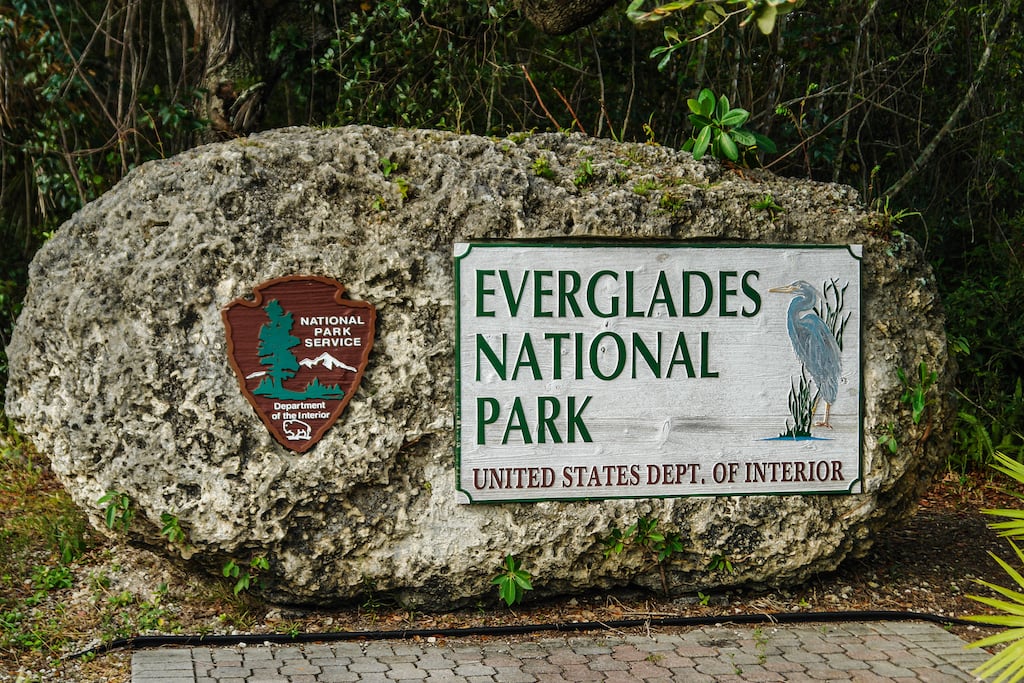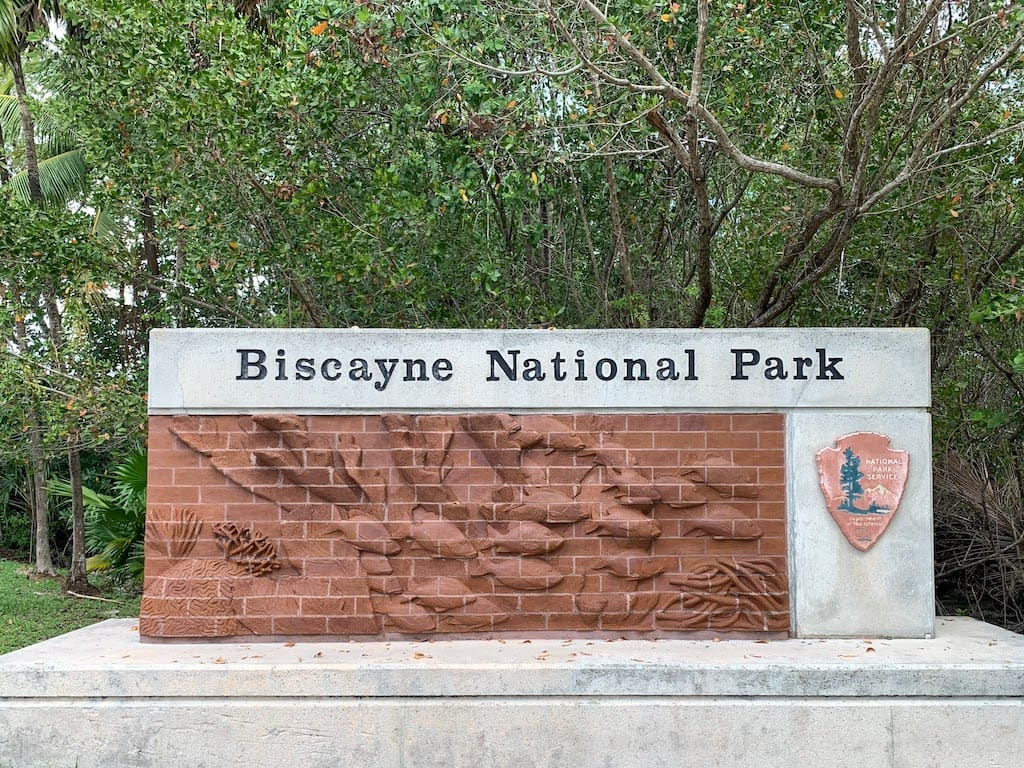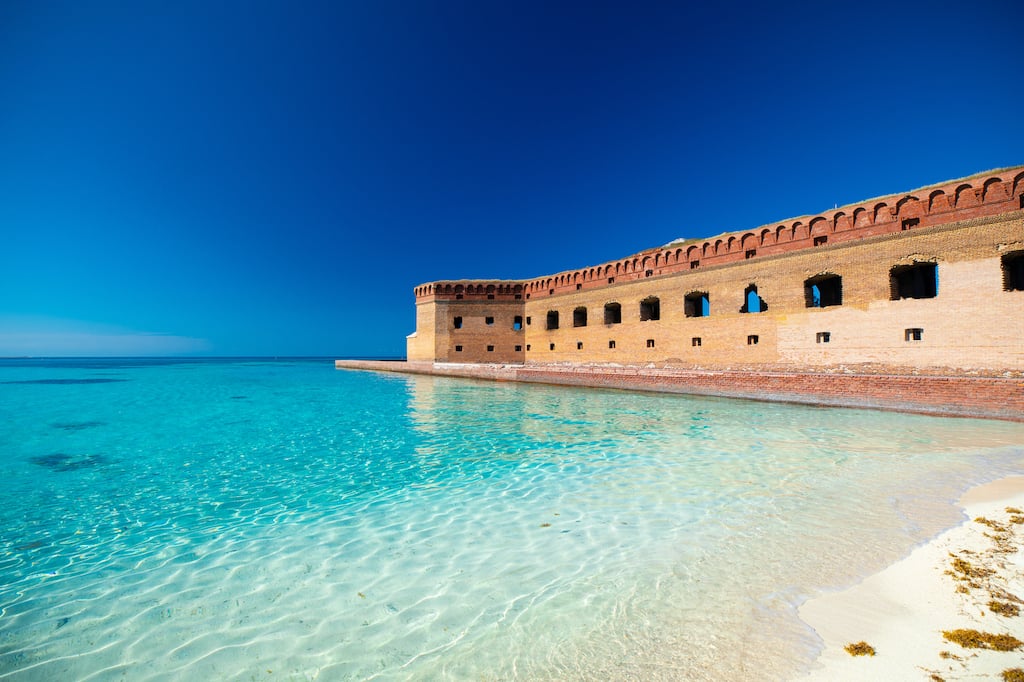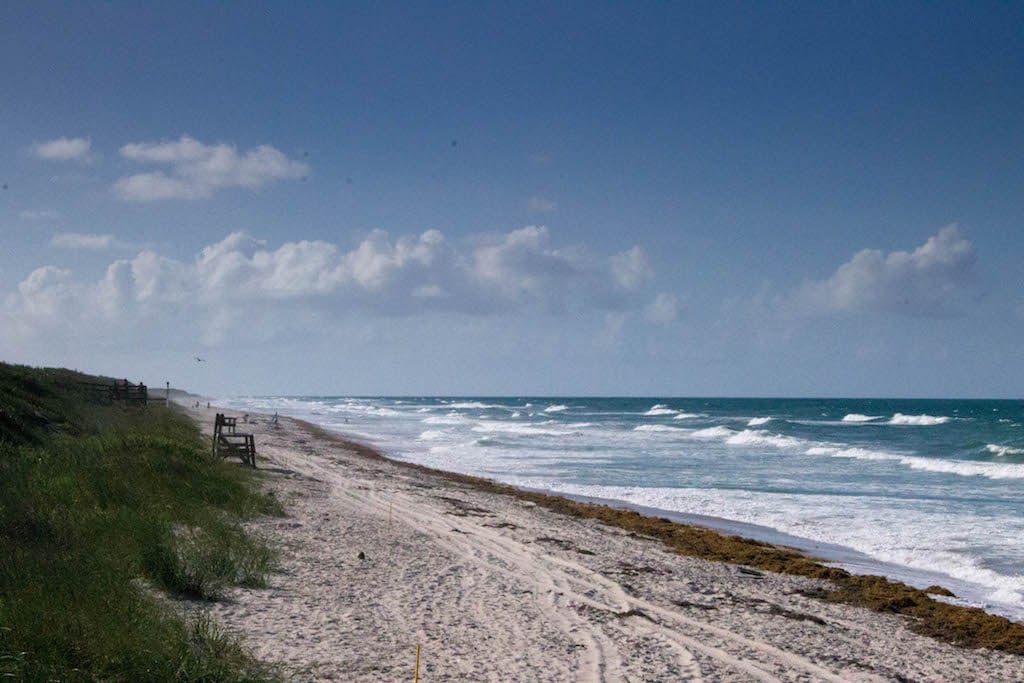National Parks in Florida
There are three major national parks in Florida, along with eight other parks which are administered by the U.S. National Park Service.
The three major national parks in Florida are:
- Everglades National Park
- Biscayne National Park
- Dry Tortugas National Park
Besides the three national parks, the National Park Service (NPS) also operates eight other parks in Florida, giving Florida 11 national parks in total.
Other national parks in Florida include:
- Fort Matanzas National Monument
- Castillo de San Marcos National Monument
- De Soto National Monument
- Canaveral National Seashore
- Gulf Islands National Seashore
- Big Cypress National Preserve
- Fort Caroline national Memorial
- Timucuan Ecological and Historic Preserve
The National Park Service also notes that Florida has:
- 1 National Heritage Site
- 2 Wild and Scenic Rivers in Florida, managed by the National Park Service
- 1,844 places on the National Register of Historic Places
- 48 National Historic Landmarks
- 18 National Natural Landmarks
- 1 World Heritage Site
- 1,184 Archeological Sites in National Parks
Visiting National Parks in Florida
National parks in Florida are unique and are quite different than other national parks I’ve visited.
Like the state itself, the big three National parks in Florida are defined by water. They have limited land access compared to other national parks which makes visiting more challenging, and sometimes more expensive.
There is no land access at all to Biscayne National Park or Dry Tortugas National Park.
Everglades National Park has several land access points, but much of the park is only accessible by boat or watercraft.
Everglades National Park
Everglades National Park is enormous.
Everglades National Park protects 2,357 square miles and includes is the largest subtropical wilderness in the United States.

Even with its massive size, Everglades National Park still only protects a small part of the broader Everglades ecosystem. Most of the Everglades remains unprotected, and is actively being destroyed.
The Everglades are extremely important to the health of Florida’s economy, environment and Florida’s future.
The Everglades are essential to the livability of Florida. The natural wonder of the Everglades serves us in so many ways, we will truly be lost if we don’t stop destroying it.
The Everglades system acts as a giant natural filter, removing pollution and excess nutrients from the water flows. The Everglades also help regulate water flow, reducing the risk of flooding and droughts.
Over time the natural flow of the Everglades ecosystem has been disrupted, with disastrous unintended consequences.
Well-intentioned, but misguided engineering schemes have blocked, drained and ravaged the Everglades. Most of these expensive projects were meant to allow development and agriculture in former Everglades wetlands.
Massive projects, including dams, canals, levees, dikes and roads have changed and destroyed natural water flow from the Everglades, creating a series of problems which plague Florida, including:
- Harmful algae blooms, including red tide
- Fish die-offs and dead marine life
- Death of coral reefs in the Florida Keys
- Destruction of water quality in the Keys
- Loss of plant and wildlife diversity
- Loss of important marine fisheries and juvenile fish habitats
- Seagrass die-offs with cascading effects
The Everglades wilderness is important for so many reasons. At the top of the list is the protection and habitat it provides for a wide range of wildlife, including:
- The Florida Panther
- American Alligators
- American Crocodiles
- Florida Manatees
- Florida Black Bear
- Countless species of birds
- Juvenile fish and many forms of marine life
- And countless other species of Florida wildlife
It’s a good idea to learn about the Everglades before visiting. This park is different than other National Parks in the U.S. The Everglades’ beauty and fascination exists in tiny details, and in the appreciation of its broad natural system. It would be tragic for a person to look at a flooded grass prairie and think “eh”. If you zoom in close, or zoom far out, you can appreciate the wonder of this place. It helps if you know what’s going on before you arrive.
Note: Advance planning is important for Everglades, more so than other parks. It’s crucial to note that you cannot access different park entrances from inside the park itself. Each entrance and section is isolated from the others, so you’d have to drive a very long distance outside the park to reach another spot.
Read more about Everglades National Park
Biscayne National Park
Biscayne National park is located in the southeast tip of Florida, southeast of Miami and east of Homestead.

The national park protects a huge body of water and many islands, which are the northern extension of the Florida Keys archipelago.
Biscayne National Park is unlike most national parks in the U.S. because it’s not accessible by land. This national park is unique for being almost completely underwater.
Some of the most popular things to do in Biscayne National Park include:
- Boat tours
- Camping (Boat camping and camping on islands)
- Snorkeling tours
- SCUBA diving
- Boating and sailing
- Fishing and lobstering
- Exploring islands, mangroves and ecosystems throughout the park
The park protects a unique marine ecosystem with a diverse array of marine life, including:
- Coral reefs
- Sensitive seagrass beds
- Many endangered species
- Habitats for juvenile fish and marine life
- Mangrove forests
- More than 500 species of fish
- Countless bird species
- Historical shipwrecks and archeological sites
- And much more
Biscayne National Park also protects a large section of the Florida Reef, which is North America’s only living coral reef.
There are two campgrounds in Biscayne National Park but they are only accessible by boat.
Biscayne National park was first established on October 18, 1968. It was initially created as a national monument. The national monument was enlarged and converted to a national park in 1980. The park was enlarged again in 1985 when Stiltsville was incorporated into the national park.
The creation of Biscayne National Park was controversial at the time. When the park was created local businessmen had already begun bulldozing the islands. Their goal was to build an oil refinery and an industrial zone, including a 6-lane highway and an industrial deepwater seaport.
Today Biscayne National Park includes 172,971 acres, or approximately 270 square miles. Approximately 95% of Key Biscayne is underwater.
Dry Tortugas National Park
Dry Tortugas National Park is one of the most isolated and remote national parks in the U.S. It’s located 70 miles west of Key West, in the middle of the Gulf of Mexico.

The national park includes a group of small islands and the surrounding ocean, which is filled with coral reef and marine life. The islands are a haven for many bird species, including shorebirds and migratory birds who return every winter.
Dry Tortugas National Park is known for its beautiful beaches, crystal-clear water, excellent snorkeling and diving opportunities. It is also known for its historic military fort, Fort Jefferson, which was built in the mid-1800s.
Dry Tortugas National Park has a primitive campground on its main island, Garden Key.
Dry Tortugas National Park is only accessible only by public ferry, private boat or seaplane.
Canaveral National Seashore
Canaveral National Seashore is located on Florida’s mid-Atlantic coast.
Canaveral National Seashore is known for its beautiful, long, empty beaches. The park is home to the longest stretch of undeveloped beach on Florida’s Atlantic coast.

This stretch of beach is also an important area for wildlife, especially for sea turtle nesting.
Canaveral National Seashore is a popular place to visit, and attracts vast numbers of visitors every year.
The most popular things to do in Canaveral National Seashore are swimming, fishing, and hiking in the park, as well as guided ranger programs and campfire programs in the evenings.
Gulf Islands National Seashore
Gulf Islands National Seashore is located in the Florida Panhandle, on the shores of the Gulf of Mexico.
It’s located near the Florida/Mississippi border. Some parts of the park are located in Mississippi and some areas located in Florida.
Most people imagine white sand beaches when they think of Gulf Islands National Seashore, but there are actually a variety of habitats in this national park.
The National Seashore protects approximately 137,929 acres, including a mix of barrier islands, parts of the Florida mainland, estuary and marine environments.
Gulf Islands National Seashore has a wide variety of wildlife, including dolphins, sea turtles, countless shorebird species and more.
The Gulf Islands National Seashore has two historic military forts: Fort Pickens and Fort Barrancas.
The main attraction at Gulf Islands National Seashore is the beautiful sugar-white sand beaches and crystal clear waters.
There are other things to do as well, including camping, swimming, fishing, kayaking, camping, nature trails, and touring historic sites.
The Gulf Islands National Seashore was established in 1971.
Fort Matanzas National Monument
Fort Matanzas National Monument is located on Florida’s northern Atlantic coast. The fort sits approximately 15 miles south of St. Augustine and the larger fort, Castillo de San Marcos, which is also a national park.
The Spanish built Fort Matanzas in 1742 to protect its settlement in St. Augustine from southern attack. The national park was established in 1924 and covers 300 acres, including the historic Fort Matanzas.
The fort is located on an island in the middle of the Matanzas River; it is only accessible via ferry.
The most popular thing to do at Fort Matanzas is to explore its well-preserved fort, including its and surrounding grounds. The park also has nature trails with excellent birdwatching and wildlife viewing opportunities.
In addition to the fort, the park protects approximately 300 acres of wildlife, including a variety of sensitive habitats throughout coastal and upland areas. Even more wilderness exists in the Matanzas State Forest, located just to the west on the mainland, across the Matanzas River.
Castillo de San Marcos National Monument
The massive Castillo de San Marcos National Monument is located in St. Augustine, in northeast Florida.
Castillo de San Marcos is one of the most popular national parks for history lovers due to its immense historical significance. Castillo de San Marcos is the oldest stone fort in the U.S., and St. Augustine is the oldest continuously inhabited city in the U.S.
The national park was established in 1924, during the presidency of Calvin Coolidge. The park covers approximately 21 acres, including the massive fort, Castillo de San Marcos.
Castillo de San Marcos was built by the Spanish in the 17th century to protect the St. Augustine from enemy attack, along with Fort Matanzas to the south.
The most popular thing to do at Castillo de San Marcos is to explore the fort and the surrounding grounds. There are exhibits throughout the fort, along with reenactments and guided tours. The park also offers beautiful views of the Matanzas River and the city of St. Augustine.
De Soto National Memorial
De Soto National Memorial is a national park located in Bradenton, south of the Tampa Bay region and north of Sarasota.
The De Soto National Memorial park was established in 1948 and covers 27 acres. It marks the approximate site where Spanish conquistador Hernando de Soto landed in 1539.
The park commemorates de Soto’s expedition, which was the first European exploration of Florida, or the southeastern U.S.
The park has a replica of a 16th-century Spanish camp, along with history and culture of the indigenous people who lived in Florida before de Soto’s arrival.
De Soto National Memorial Park has beautiful views of the Manatee River, along with nature trails, a picnic area.
Timucuan Ecological and Historic Preserve
Timucuan Ecological and Historic Preserve is a national park located in Jacksonville, in the northeastern tip of Florida.
The preserve is located in an area of vast tidal wetlands. It sits on the banks of Clapboard Creek, which feeds into the St. Johns River. The preserve is located to the west of Little Talbot Island State Park.
The national ecological and historic preserve includes many historical sites, along with sensitive wildlife habitats, wetlands and sensitive ecosystems.
This national park includes the Fort Caroline National Memorial, Kingsley Plantation and other historical sites.
The park is named after the indigenous Timucuan people of Florida, who lived in Florida for thousands of years before Europeans “discovered” Florida in the mid-1500s.
The Timucuan Ecological and Historic Preserve park was established as a national park site in 1988. The grounds cover approximately 72 square miles.
Fort Caroline National Memorial
Fort Caroline National Memorial is located inside the Timucuan Ecological and Historic Preserve.
The park pays tribute to a short period of French colonial presence in Florida in the mid-1500s, when they unsuccessfully tried to challenge Spanish dominance in North America.
The park also pays tribute to the history of indigenous people who lived in Florida long before the Spanish and French colonization, which stretches back many thousands of years.
Fort Caroline was established as a national park in 1953 and covers approximately 128 acres.
The park has a replica of Fort Caroline, along with exhibits on the history and culture of the French settlers and the native Timucua people who lived in the area.
The park also has nature trails, a visitor center, and scenic views of surrounding waterways.
Big Cypress National Preserve
Big Cypress National Preserve is located in south Florida, “next door” to Florida Everglades National Park.
Big Cypress National Preserve protects 729,000 acres of a delicate and diverse ecosystem, including wetlands, flooded prairie, swamp, cypress forests and others.
The preserve is home to a diverse range of wildlife, including many protected and endangered species like the Florida panther, the West Indian manatee and others.
The national preserve has many things to do, including wildlife and nature viewing, camping, hiking, fishing, paddling, guided tours, and more.
The park also offers beautiful drives through the Florida Everglades, including the famous Tamiami Trail, which runs through the heart of the preserve and played a big role in destroying the health and water flows of the Everglades.
Big cypress National Preserve is one of several trailheads which mark the start or end of The Florida Trail.
Big Cypress National Preserve was established in 1974.
Frequently Asked Questions
Readers ask us these questions frequently, so here they are!
How many national parks are in Florida?
According to the National Park Service (NPS) definition, there are eleven national parks in Florida. Florida has three officially designated “national parks”, along with eight other parks which are administered by the National Park Service, making eleven national parks in total. The 8 additional National Park Service parks in Florida consist of national seashores, national monuments, national preserves, national memorials and national ecological and historical preserves.
What are Florida’s major national parks?
The three major national parks in Florida are Everglades National Park, Biscayne National Park and Dry Tortugas National Park. There are eight additional national parks in Florida which are administered by the National Parks Service, making eleven in total.
What is Florida’s largest National Park?
Everglades National Park is the largest national park in Florida.
What Florida National Park is 99% underwater?
Dry Tortugas National Park is 99% underwater. Biscayne National Park is approximately 95% underwater.
What is the least visited national park in Florida?
Dry Tortugas National Park is the least-visited national park in Florida because of its remote location and difficult access, which is only possible via ferry, seaplane or private boat.
